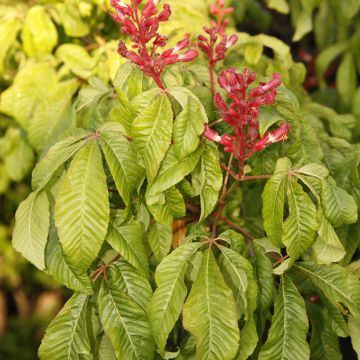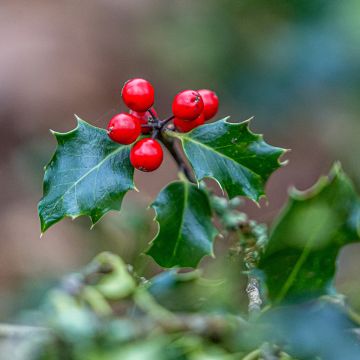

Aesculus chinensis - Chinese horse chestnut


Aesculus chinensis - Chinese horse chestnut


Aesculus chinensis - Chinese horse chestnut
Aesculus chinensis - Chinese horse chestnut
Aesculus chinensis
Chinese horse chestnut, Chinese buckeye
Special offer!
Receive a €20 voucher for any order over €90 (excluding delivery costs, credit notes, and plastic-free options)!
1- Add your favorite plants to your cart.
2- Once you have reached €90, confirm your order (you can even choose the delivery date!).
3- As soon as your order is shipped, you will receive an email containing your voucher code, valid for 3 months (90 days).
Your voucher is unique and can only be used once, for any order with a minimum value of €20, excluding delivery costs.
Can be combined with other current offers, non-divisible and non-refundable.
Home or relay delivery (depending on size and destination)
Schedule delivery date,
and select date in basket
This plant carries a 24 months recovery warranty
More information
We guarantee the quality of our plants for a full growing cycle, and will replace at our expense any plant that fails to recover under normal climatic and planting conditions.
Would this plant suit my garden?
Set up your Plantfit profile →
Description
Aesculus chinensis, also known as the Chinese horse chestnut tree, is a Chinese cousin of the more well-known and widely planted Common Horse Chestnut. It is a large deciduous tree with a spreading habit and palmate leaves, which are finer than those of the common chestnut. It offers a beautiful spring flowering with upright panicles of white flowers, touched with yellow and red. This Chinese chestnut tree also produces large fruits covered in soft thorns. These fruits contain one to three large, shiny brown seeds, similar to "conkers".
Aesculus chinensis belongs to the Sapindaceae or Hippocastanaceae family according to different classifications. It differs from the Indian chestnut tree in its larger size, slower growth, narrower leaflets, shorter inflorescences, flowers tinged with red and yellow at the base, and better resistance to very cold winters. The Chinese chestnut tree is naturally found in mixed forests in mountainous regions of China. This tree, which grows relatively slowly but reaches an imposing size, can reach heights between 15 and 25 metres. It has a wide, spreading crown and remarkable deciduous foliage. Its leaves are compound palmate, with 5 to 7 lanceolate to elliptical leaflets, measuring approximately 20 to 40 cm in length. They are dark green and glossy on the upper surface, while the lower surface is paler. The leaf edges are toothed. The leaves turn yellow in autumn before falling. In spring, typically in May, the tree is covered in attractive flowers. Its flowers are grouped in upright panicles measuring between 10 and 25 cm in length. Each flower has a diameter of 2 to 3 cm and is white with a yellow and red base. They are nectar-rich and attract bees and butterflies. After pollination, the tree produces spherical to oblong fruits covered in soft thorns. These fruits contain 1 to 3 brown, shiny seeds commonly known as "chestnuts". The fruits ripen in autumn and may persist on the tree during winter. The bark of the Chinese chestnut tree is grey-brown and smooth when the tree is young. With age, it becomes rougher and fissured, adding an interesting texture to the trunk.
The Chinese chestnut tree prefers rich, well-drained, slightly acidic soils, although it is quite adaptable. It can be planted as a standalone specimen in a well-cleared location, on a large lawn, or as a shade tree. It also looks good at the edge of a large property overlooking the countryside. Consider its future growth before planting it in the garden. This tree can be integrated into a themed garden, such as an Asian garden or a garden of native plants from China, in association with other plants native to this region. Particularly Japanese maples, Camellias, and Fargesia bamboos, for example, under the Chinese chestnut tree or in a separate bed.
Report an error about the product description
Aesculus chinensis - Chinese horse chestnut in pictures


Plant habit
Flowering
Foliage
Botanical data
Aesculus
chinensis
Sapindaceae
Chinese horse chestnut, Chinese buckeye
China
Other Aesculus - Horse Chestnut
View all →Planting and care
The Chinese horse chestnut tree should be planted in spring or autumn in deep soil, preferably quite rich, slightly acidic or neutral. Place it in a sunny or semi-shaded position, in a clear location. Reserve enough space for it, as it can reach a width of more than 15m for the crown. Water and mulch to keep the soil cool for young plants. Once well-rooted, it will generally be happy with rainwater. Pruning may be necessary for large specimens to limit the size of the crown or remove lower branches: do this in winter. To limit attacks from pests (rarely fatal), collect the leaves in autumn and remove them. Trapping male butterflies using a sexual pheromone (funnel traps) limits attacks.
Planting period
Intended location
Care
This item has not been reviewed yet - be the first to leave a review about it.
Similar products
Haven't found what you were looking for?
Hardiness is the lowest winter temperature a plant can endure without suffering serious damage or even dying. However, hardiness is affected by location (a sheltered area, such as a patio), protection (winter cover) and soil type (hardiness is improved by well-drained soil).

Photo Sharing Terms & Conditions
In order to encourage gardeners to interact and share their experiences, Promesse de fleurs offers various media enabling content to be uploaded onto its Site - in particular via the ‘Photo sharing’ module.
The User agrees to refrain from:
- Posting any content that is illegal, prejudicial, insulting, racist, inciteful to hatred, revisionist, contrary to public decency, that infringes on privacy or on the privacy rights of third parties, in particular the publicity rights of persons and goods, intellectual property rights, or the right to privacy.
- Submitting content on behalf of a third party;
- Impersonate the identity of a third party and/or publish any personal information about a third party;
In general, the User undertakes to refrain from any unethical behaviour.
All Content (in particular text, comments, files, images, photos, videos, creative works, etc.), which may be subject to property or intellectual property rights, image or other private rights, shall remain the property of the User, subject to the limited rights granted by the terms of the licence granted by Promesse de fleurs as stated below. Users are at liberty to publish or not to publish such Content on the Site, notably via the ‘Photo Sharing’ facility, and accept that this Content shall be made public and freely accessible, notably on the Internet.
Users further acknowledge, undertake to have ,and guarantee that they hold all necessary rights and permissions to publish such material on the Site, in particular with regard to the legislation in force pertaining to any privacy, property, intellectual property, image, or contractual rights, or rights of any other nature. By publishing such Content on the Site, Users acknowledge accepting full liability as publishers of the Content within the meaning of the law, and grant Promesse de fleurs, free of charge, an inclusive, worldwide licence for the said Content for the entire duration of its publication, including all reproduction, representation, up/downloading, displaying, performing, transmission, and storage rights.
Users also grant permission for their name to be linked to the Content and accept that this link may not always be made available.
By engaging in posting material, Users consent to their Content becoming automatically accessible on the Internet, in particular on other sites and/or blogs and/or web pages of the Promesse de fleurs site, including in particular social pages and the Promesse de fleurs catalogue.
Users may secure the removal of entrusted content free of charge by issuing a simple request via our contact form.
The flowering period indicated on our website applies to countries and regions located in USDA zone 8 (France, the United Kingdom, Ireland, the Netherlands, etc.)
It will vary according to where you live:
- In zones 9 to 10 (Italy, Spain, Greece, etc.), flowering will occur about 2 to 4 weeks earlier.
- In zones 6 to 7 (Germany, Poland, Slovenia, and lower mountainous regions), flowering will be delayed by 2 to 3 weeks.
- In zone 5 (Central Europe, Scandinavia), blooming will be delayed by 3 to 5 weeks.
In temperate climates, pruning of spring-flowering shrubs (forsythia, spireas, etc.) should be done just after flowering.
Pruning of summer-flowering shrubs (Indian Lilac, Perovskia, etc.) can be done in winter or spring.
In cold regions as well as with frost-sensitive plants, avoid pruning too early when severe frosts may still occur.
The planting period indicated on our website applies to countries and regions located in USDA zone 8 (France, United Kingdom, Ireland, Netherlands).
It will vary according to where you live:
- In Mediterranean zones (Marseille, Madrid, Milan, etc.), autumn and winter are the best planting periods.
- In continental zones (Strasbourg, Munich, Vienna, etc.), delay planting by 2 to 3 weeks in spring and bring it forward by 2 to 4 weeks in autumn.
- In mountainous regions (the Alps, Pyrenees, Carpathians, etc.), it is best to plant in late spring (May-June) or late summer (August-September).
The harvesting period indicated on our website applies to countries and regions in USDA zone 8 (France, England, Ireland, the Netherlands).
In colder areas (Scandinavia, Poland, Austria...) fruit and vegetable harvests are likely to be delayed by 3-4 weeks.
In warmer areas (Italy, Spain, Greece, etc.), harvesting will probably take place earlier, depending on weather conditions.
The sowing periods indicated on our website apply to countries and regions within USDA Zone 8 (France, UK, Ireland, Netherlands).
In colder areas (Scandinavia, Poland, Austria...), delay any outdoor sowing by 3-4 weeks, or sow under glass.
In warmer climes (Italy, Spain, Greece, etc.), bring outdoor sowing forward by a few weeks.


















































